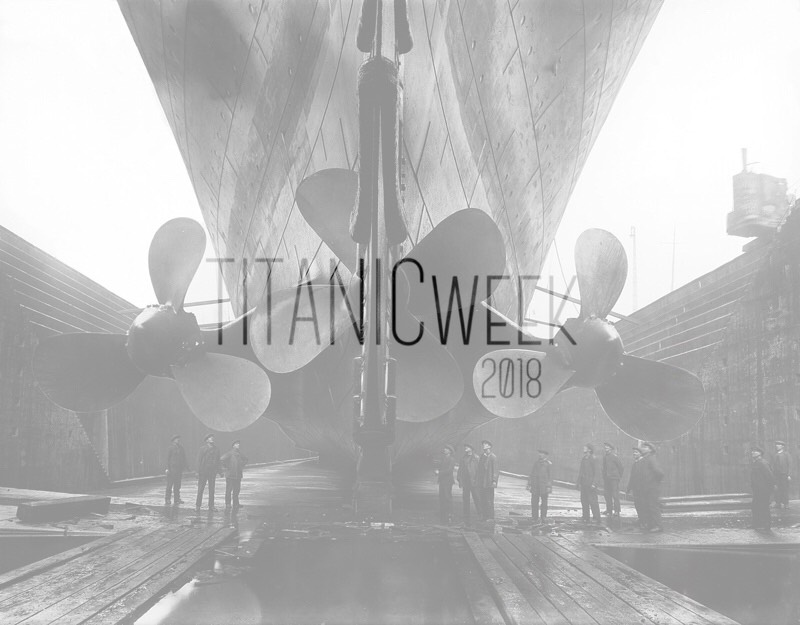Ghost Boats & Lost Souls
Recovery of bodies from Titanic took weeks.
The Canadian vessel Mackay-Bennett was tasked with collecting them, and they were overwhelmed with the job--there were more bodies than the ship could hold.
On board with crew and supplies were a priest and an embalmer.
First-class passengers were embalmed and stored in coffins; second-class, the same except for canvas instead of coffins. Third-class corpses and many crewmembers were buried at sea. Of these 116, only 56 were identified.

Recovery of a Titanic victim by the crew of the Mackay-Bennett.
Out of over 1,500 dead, a total of 328 bodies were found by the Mackay-Bennett, and 306 of those were recovered. Still, this was far more than they had prepared for.
In addition, the bodies were saltwater-bleached, bruised, crushed, with broken limbs and all cut up. The sinking is often portrayed as sanitary, depicting vistims that died frozen but otherwise unharmed.
In truth, it was gruesome.

Captain and crew of the Mackay-Bennett, taken between 1910 and 1915. From the George Grantham Bain Collection, courtesy of the Library of Congress.
Multiple crewmembers of the Mackay-Bennett suffered PTSD for the rest of their lives, including one man named Clifford Crease, who, at the end of his long life, even elected to be interred mere feet from the grave of a Titanic victim whose recovery had irrevocably scarred him. He honored the memory of this unidentified passenger all of his life.
Frederick Hamilton, a cable engineer on Mackay-Bennett, wrote about the reaping in his diary.
The tolling of the bell summoned all hands to the forecastle where thirty bodies are ready to be committed to the deep, each carefully weighed and carefully sewn up in canvas. It is a weird scene, this gathering. The crescent moon is shedding a faint light on us, as the ship lays wallowing in the great rollers. The funeral service is conducted by the Reverent Canon Hind, for nearly an hour the words For as must as it hath pleased - - ' we therefore commit his body to the deep' are repeated and at each interval comes, splash! as the weighted body plunges into the sea, there to sink to a depth of about two miles. Splash, splash, splash.
© Caption.
Even then, there were others to find, and many more that never would be.
Collapsible A had been launched only moments before submersion--so close to, in fact, that it was washed away without the officers being able to pop up its canvas sides.
Thus, even though people found it and boarded it, it had taken on water--so much, in fact, that those people were standing on it were knee-deep in water, and dying.
They did this for hours until they were rescued by Fifth Officer Harold Lowe, who was the only officer to attempt rescue of more people from the water.
Out of the thirty or so survivors who made it to Collapsible A, Officer Lowe found no more than a dozen survivors.
And many frozen corpses.

Fifth Officer Harold Lowe, the only Titanic officer to return for survivors.
Lowe left three bodies in Collapsible A, which he commented on in his characteristically straightforward tone during the United States Senate Inquiry.
As to the three people that I left on her - of course, I may have been a bit hard hearted, I can not say - but I thought to myself, "I am not here to worry about bodies; I am here for life, to save life, and not to bother about bodies," and I left them.
...The people on the raft told me they had been dead some time. I said, "Are you sure they are dead?" They said, "Absolutely sure." I made certain they were dead, and questioned them one and all before I left this collapsible.
On May 13, 1912, the crew of the Oceanic were approximately 200 miles from the wreck site when the spotted a strangely shaped plank in the flat distance. Using binoculars, they realized it wasn't a plank. It was a lifeboat.
And it wasn't vacant.
Sire Shane Leslie, on board Oceanic, recalled, "Orders from the bridge dispatched a lifeboat with an officer and a medical officer. What followed was ghastly."

Collapsible A, boarded by crewmembers of Oceanic on May 13, 1912.
Six Oceanic crewmen rowed out to meet the partially collapsed Collapsible A.
Slumped within, faces blackened from rot and a month under Atlantic sunlight, were three "unrecognizable" corpses: two firemen, and one wearing a dinner jacket.
According to the firsthand account by Sir Shane Leslie, the arms of one corpse snapped off in the crewmember's hands.
Two sailors could be seen, their hair bleached by exposure to sun and salt, and a third figure, wearing evening dress, flat on the benches. All three were dead and the bodies had been tossing on the Atlantic swell under the open sky ever since it had seen the greatest of ocean liners sink.
The names of the sailors, reported to be firemen, are to date unknown, but the well-dressed corpse was identified: First-class passenger Thomson Beattie, 37, from Canada.

Thomson Beattie, whose body was recovered from Collapsible A on May 13, 1912, one month after Titanic sank.
The Oceanic crew wrapped the three corpses in canvas, said a prayer, and buried them at sea.
Upon hauling the lifeboat on board, the Oceanic discovered something else: a gold wedding ring. Inscribed in its band was "Edvard to Gerda."
It would later come to light that the wedding band belonged to Swedish third-class passenger Elin Gerda Lindell. She and her husband Edvard had boarded Titanic bound for a new life in Hartford, Connecticut.
After sliding down the steepening deck into the ocean, the couple had both made it to Collapsible A.
But Gerda had been too cold, and the others too weak, to pull her aboard. She eventually fell silent and still, and Edvard was forced to let her drift away.
Before he let go, he removed her wedding band.

Gerda Lindell’s wedding band, as displayed in Titanic: The Exhibition in New York City, 2022.
© soliloquism, 2022. Courtesy of #TitanicExhibitionNYC.
According to survivor August Wennerstrom, "Edvard's hair turned all gray in lesser time than 30 minutes".
Edvard died shortly thereafter, bereft at the loss of his wife, and still cradling her wedding ring. It is thought that his body was pushed overboard to lighten the load of the partially submerged Collapsible A, but the wedding ring was dropped in the process.
Neither Edvard nor Gerda Lindell were ever recovered.
SOURCE MATERIAL
https://www.encyclopedia-titanica.org/rms-oceanic-finds-collapsible-lifeboat-a-adrift--22045.html
https://www.titanicinquiry.org/ships/oceanic.php
https://timmaltin.com/2019/05/16/titanics-lifeboats/
https://www.encyclopedia-titanica.org/titanic-victim/edvard-bengtsson-lindell.html
https://www.encyclopedia-titanica.org/titanic-victim/elin-gerda-lindell.html
https://www.encyclopedia-titanica.org/titanic-victim/thomson-beattie.html

